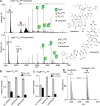Real-Time Biosynthetic Reaction Monitoring Informs the Mechanism of Action of Antibiotics
- PMID: 38428018
- PMCID: PMC10941186
- DOI: 10.1021/jacs.4c00081
Real-Time Biosynthetic Reaction Monitoring Informs the Mechanism of Action of Antibiotics
Abstract
The rapid spread of drug-resistant pathogens and the declining discovery of new antibiotics have created a global health crisis and heightened interest in the search for novel antibiotics. Beyond their discovery, elucidating mechanisms of action has necessitated new approaches, especially for antibiotics that interact with lipidic substrates and membrane proteins. Here, we develop a methodology for real-time reaction monitoring of the activities of two bacterial membrane phosphatases, UppP and PgpB. We then show how we can inhibit their activities using existing and newly discovered antibiotics such as bacitracin and teixobactin. Additionally, we found that the UppP dimer is stabilized by phosphatidylethanolamine, which, unexpectedly, enhanced the speed of substrate processing. Overall, our results demonstrate the potential of native mass spectrometry for real-time biosynthetic reaction monitoring of membrane enzymes, as well as their in situ inhibition and cofactor binding, to inform the mode of action of emerging antibiotics.
Conflict of interest statement
The authors declare the following competing financial interest(s): C.V.R. is a cofounder of and consultant at OMass Therapeutics. The remaining authors declare no competing interests.
Figures





Similar articles
-
Potential Risk of Spreading Resistance Genes within Extracellular-DNA-Dependent Biofilms of Streptococcus mutans in Response to Cell Envelope Stress Induced by Sub-MICs of Bacitracin.Appl Environ Microbiol. 2020 Aug 3;86(16):e00770-20. doi: 10.1128/AEM.00770-20. Print 2020 Aug 3. Appl Environ Microbiol. 2020. PMID: 32532873 Free PMC article.
-
Chemistry and Biology of Teixobactin.Chemistry. 2018 Apr 11;24(21):5406-5422. doi: 10.1002/chem.201704167. Epub 2017 Dec 12. Chemistry. 2018. PMID: 28991382 Review.
-
Undecaprenyl pyrophosphate phosphatase confers low-level resistance to bacitracin in Enterococcus faecalis.J Antimicrob Chemother. 2013 Jul;68(7):1583-93. doi: 10.1093/jac/dkt048. Epub 2013 Mar 3. J Antimicrob Chemother. 2013. PMID: 23460607
-
Multidrug Efflux Pumps and the Two-Faced Janus of Substrates and Inhibitors.Acc Chem Res. 2021 Feb 16;54(4):930-939. doi: 10.1021/acs.accounts.0c00843. Epub 2021 Feb 4. Acc Chem Res. 2021. PMID: 33539084 Free PMC article.
-
Discovery, synthesis, and optimization of teixobactin, a novel antibiotic without detectable bacterial resistance.J Pept Sci. 2022 Nov;28(11):e3428. doi: 10.1002/psc.3428. Epub 2022 Jun 13. J Pept Sci. 2022. PMID: 35610021 Review.
Cited by
-
Antibacterial carbon dots.Mater Today Bio. 2024 Dec 5;30:101383. doi: 10.1016/j.mtbio.2024.101383. eCollection 2025 Feb. Mater Today Bio. 2024. PMID: 39811607 Free PMC article. Review.
-
Real-time capture of reactive intermediates in an enzymatic reaction: insights into a P450-catalyzed oxidation.Chem Sci. 2025 May 19;16(25):11322-11330. doi: 10.1039/d5sc02240a. eCollection 2025 Jun 25. Chem Sci. 2025. PMID: 40438169 Free PMC article.
-
Lipopeptide antibiotics disrupt interactions of undecaprenyl phosphate with UptA.Proc Natl Acad Sci U S A. 2024 Oct 8;121(41):e2408315121. doi: 10.1073/pnas.2408315121. Epub 2024 Oct 3. Proc Natl Acad Sci U S A. 2024. PMID: 39361645 Free PMC article.
References
-
- Chu J.; Vila-Farres X.; Inoyama D.; Ternei M.; Cohen L. J.; Gordon E. A.; Reddy B. V. B.; Charlop-Powers Z.; Zebroski H. A.; Gallardo-Macias R.; et al. Discovery of MRSA active antibiotics using primary sequence from the human microbiome. Nat. Chem. Biol. 2016, 12 (12), 1004–1006. 10.1038/nchembio.2207. - DOI - PMC - PubMed
Publication types
MeSH terms
Substances
Grants and funding
LinkOut - more resources
Full Text Sources
Medical

